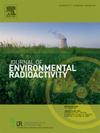森林中放射性核素运动的动力学:切尔诺贝利和福岛影响研究综述
IF 2.1
3区 环境科学与生态学
Q3 ENVIRONMENTAL SCIENCES
引用次数: 0
摘要
切尔诺贝利(1986年)和福岛(2011年)核事故留下了持久的环境影响,特别是在森林生态系统中。这些地区的放射性污染已经持续了几十年,不仅影响了景观,也影响了这些生态系统内的生物循环。本次审查的重点是森林环境中放射性核素运动的长期动态,特别审查了切尔诺贝利和福岛的案例研究。我们探讨了放射性核素如何通过森林土壤、水、植物和野生动物运输,突出了土壤类型、气候和森林结构等关键因素。本文综述了放射性物质在树木、蘑菇和野生动物体内的生物积累研究,并讨论了放射性核素与生物成分之间的相互作用。通过比较这两个地点,本综述确定了共同趋势和区域特定动态,为核事故后森林管理和环境修复的更广泛影响提供了见解。本文最后指出了森林生态系统中放射性核素行为的知识缺口,并提出了未来研究的方向。本文章由计算机程序翻译,如有差异,请以英文原文为准。
Dynamics of radionuclide movement in forests: A review of Chernobyl and Fukushima impact studies
The Chernobyl (1986) and Fukushima (2011) nuclear accidents have left lasting environmental impacts, particularly in forest ecosystems. Radioactive contamination in these areas has persisted for decades, influencing not only the landscape but also the biological cycles within these ecosystems. This review focuses on the long-term dynamics of radionuclide movement in forest environments, specifically examining the case studies of Chernobyl and Fukushima. We explore how radionuclides are transported through forest soil, water, plants, and wildlife, highlighting key factors such as soil type, climate, and forest structure. The review synthesizes research on the bioaccumulation of radioactive materials in trees, mushrooms, and wildlife, and discusses the interactions between radionuclides and biotic components. By comparing the two sites, this review identifies common trends and region-specific dynamics, offering insights into the broader implications for forest management and environmental remediation in post-nuclear accident landscapes. The paper concludes by identifying knowledge gaps and suggesting directions for future research into radionuclide behavior in forest ecosystems.
求助全文
通过发布文献求助,成功后即可免费获取论文全文。
去求助
来源期刊

Journal of environmental radioactivity
环境科学-环境科学
CiteScore
4.70
自引率
13.00%
发文量
209
审稿时长
73 days
期刊介绍:
The Journal of Environmental Radioactivity provides a coherent international forum for publication of original research or review papers on any aspect of the occurrence of radioactivity in natural systems.
Relevant subject areas range from applications of environmental radionuclides as mechanistic or timescale tracers of natural processes to assessments of the radioecological or radiological effects of ambient radioactivity. Papers deal with naturally occurring nuclides or with those created and released by man through nuclear weapons manufacture and testing, energy production, fuel-cycle technology, etc. Reports on radioactivity in the oceans, sediments, rivers, lakes, groundwaters, soils, atmosphere and all divisions of the biosphere are welcomed, but these should not simply be of a monitoring nature unless the data are particularly innovative.
 求助内容:
求助内容: 应助结果提醒方式:
应助结果提醒方式:


